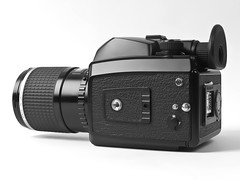Pentax 645N

|
| Pentax 645N image by Howie Mudge (Image rights) |
The 645N is a auto focus medium format SLR film camera manufactured by Pentax in 1997. It is based on the previous Pentax 645 model which is a manual focus camera. It is the first medium format auto focus SLR system to be available. Competing cameras such as Contax 645 AF and Mamiya 645AF arrived two years later in 1999.
The Pentax 645N body is very similar to the previous 645, but unlike the previous model which required using multiple buttons for adjusting most settings, this model uses knobs for many of the functions. It is compatible with Pentax 645 series of Pentax-FA (auto focus) and Pentax-A (Manual focus) lenses. Pentax also manufactured an adapter for using Pentax 6x7 lenses.
The electronic vertical-travel cloth focal plane shutter has speeds of 4 seconds to 1/1,000 of a second. The shutter release has a screw in cable release. The electronic flash sync speed is at 1/60 of a sec. A self-timer is available on the shutter release collar, it has a delay of 12 seconds.
The exposure meter supports a evaluative, center-weighted and spot meter modes. It has a range of 2 to 21 EV with f/2.8 lens. Film sensitivity can be set from 6 to 6,400 ISO. The supported exposure modes include P, aperture-priority, shutter-priority and manual exposure modes. Changing modes is simple. To use P mode set the shutter dial and aperture ring to A, set shutter dial to A and desired aperture for aperture-priority, set aperture dial to A and select desired shutter speed for shutter-priority.
The finder uses and interchangeable screens design and can be changed to grid, microprism or split-image screens. The LCD on the top shoulder has indicators for data imprinting, battery, ISO, and the exposure counter. When loaded with film the exposure counter is always displayed even when the camera is off.
It is powered by 6x AA batteries which last approx 130 rolls of 120, or 100 rolls of 220 film.

|
| top view image by Robin Parmar (Image rights) |

|
| left view image by Dmitry Krasitsky (Image rights) |
645NII
The Pentax 645NII released in 2001, is a revision that supports mirror lock up, half step settings as well as a 6 second manual shutter speed.
Links
- Pentax 645N and 645NII manual at Mike Butkus Orphan Cameras
| Japan Camera Grand Prix | |
|---|---|
| Camera of the year
1984: Nikon FA | 1985: Minolta α-7000 | 1986: Canon T90 | 1987: Canon EOS 650 | 1988: Kyocera Samurai | 1989: Nikon F4 | 1990: Canon EOS 10 | 1991: Contax RTS III | 1992: Pentax Z-1 | 1993: Canon EOS 5 | 1994: Minolta α-707si | 1995: Contax G1 | 1996: Minolta TC-1 | 1997: Nikon F5 | 1998: Pentax 645N | 1999: Minolta α-9 | 2000: Canon EOS-1V | 2001: Minolta α-7 | 2002: Canon EOS-1D | 2003: Canon EOS-1Ds | 2004: Nikon D70 | 2005: Konica Minolta α-7 Digital | 2006: Nikon D200 | 2007: Pentax K10D | 2008: Nikon D3 | 2009: Canon EOS 5D Mark II | 2010: Olympus Pen E-P1 | 2011: Pentax 645D | 2012: Nikon D800 | 2013: Sony DSC-RX1 | 2014: Nikon Df | 2015: Canon EOS 7D Mark II | 2016: Sony α7R II | 2017: Olympus OM-D E-M1 Mark II | 2018: Sony α9 | 2019: Lumix S1R | 2020: Sony α7R IV | 2021: Sony α1 | 2022: Nikon Z9 | 2023: Sony α7R V Special Prize Editor | |